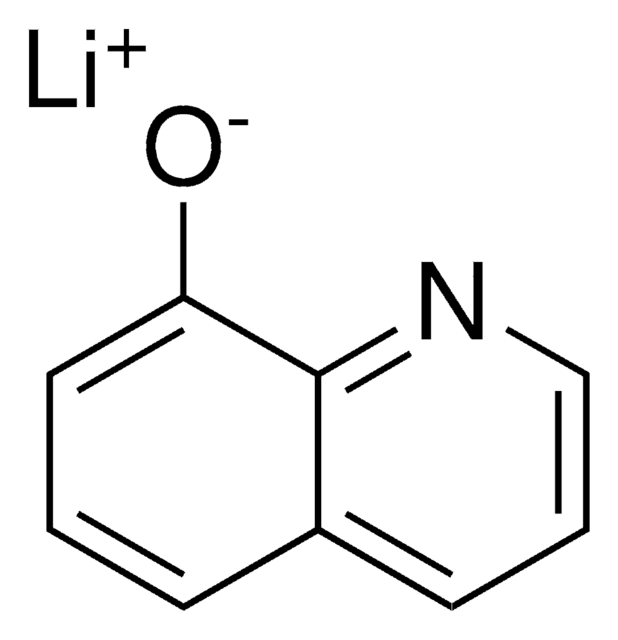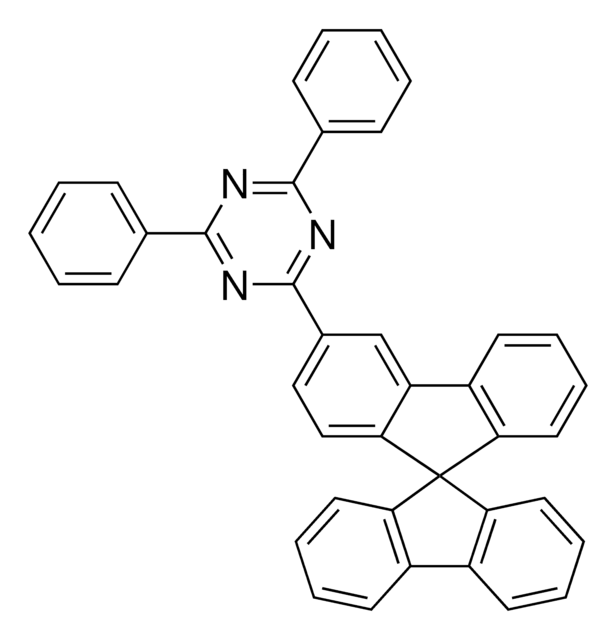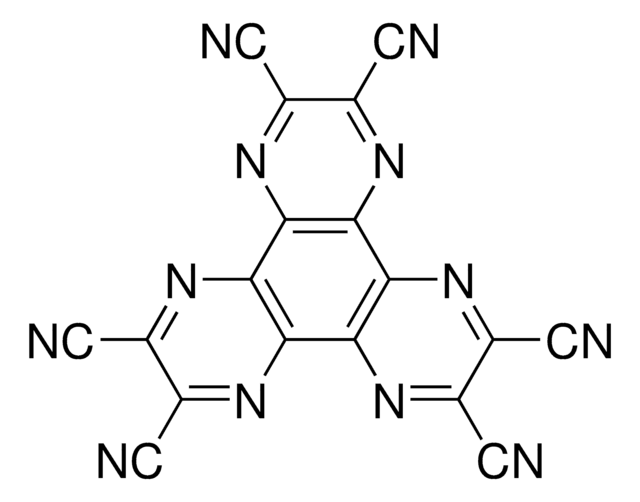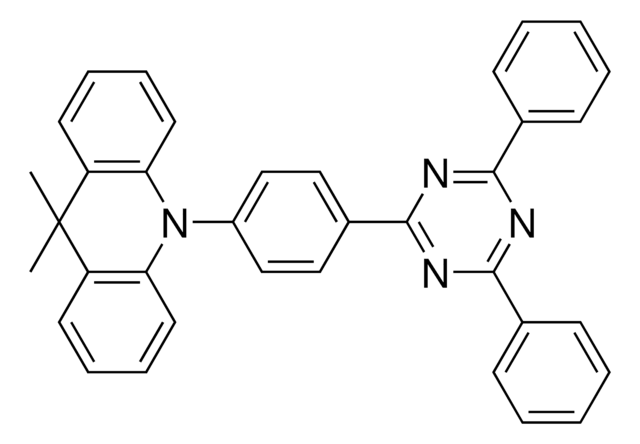925756
N-([1,1′-Biphenyl]-4-yl)-9,9-dimethyl-N-(4-(9-phenyl-9H-carbazol-3-yl)phenyl)-9H-fluoren-2-amine
≥97%
Synonym(e):
BCFN
About This Item
Empfohlene Produkte
Beschreibung
PL: 413 nm (in DCM)
Qualitätsniveau
Assay
≥97%
Form
powder
Farbe
white to yellow
Energie der Orbitale
HOMO 5.3 eV
LUMO 3.2 eV
λ
in dichloromethane
UV-Absorption
λ: 353 nm Amax
InChI
1S/C51H38N2/c1-51(2)47-19-11-9-17-43(47)44-31-30-42(34-48(44)51)52(40-26-21-36(22-27-40)35-13-5-3-6-14-35)41-28-23-37(24-29-41)38-25-32-50-46(33-38)45-18-10-12-20-49(45)53(50)39-15-7-4-8-16-39/h3-34H,1-2H3
InChIKey
GJWBRYKOJMOBHH-UHFFFAOYSA-N
Anwendung
BCFN is a good morphologically stable material with Tg of 125 °C and Td of 375 °C.
With a ET of 2.58 eV, BCFN is also a very good charge transporting layer material due to its large band gap (Eg = 3.1 eV) 2 for green, red and white phosphorescent organic light-emitting diodes (PhOLEDs).
OLED Device Performance:
BCFN increase the hole transport mobility of PVK (pure PVK: 2.09×10-9 V cm-1 S-1; 30% of BCFN in PVK: 9.86×10-7 V cm-1 S-1; 50% of BCFN in PVK: 1.15×10-5 V cm-1 S-1):
1. ITO/PEDOT:PSS (40 nm)/PVK:BCFN (3:7, 20 nm)/BCFN:PFO (x:1-x, 80 nm)/CsF (1.5 nm)/Al (120 nm)
Color: Blue
BCFN in combination of ET1 to act as EML in forming exciplex and improve device performance:
2. ITO/HIL/HTL/(ET1+P1) or (ET1+BCFN+P1(doped)/ETL/ LiF/Al
Color: red
Device emission area of 81cm2, and at 1000 cd m-2, the efficiency exceeds 200 lm/W and the EQE exceeds 50 %.
lifespan@95: from 71h to 133h
BCFN in combination with Ir(piq)2(acac) as electron scavenger layer:
3. ITO/NDP series in BCFN (3wt.%, 10nm)/BCFN(160nm) or BCFN(130nm)+BCFN:Ir(piq)2(acac)(2wt.%, 10nm)+BCFN(20)/ [Ir(TMSBppy)ppy2]:BPTZBC (10 wt.%, 40nm))/ TPBi:Liq (1:1 wt. % ratio, 36nm)/ Liq (0.1nm)/Al (60 nm)
Color: yellow
Efficiencies are not affected.
lifespan@95: from 71h to 133h
Lagerklassenschlüssel
11 - Combustible Solids
WGK
WGK 3
Hier finden Sie alle aktuellen Versionen:
Analysenzertifikate (COA)
Leider sind derzeit keine COAs für dieses Produkt online verfügbar.
Wenn Sie Hilfe benötigen, wenden Sie sich bitte an Kundensupport
Besitzen Sie dieses Produkt bereits?
In der Dokumentenbibliothek finden Sie die Dokumentation zu den Produkten, die Sie kürzlich erworben haben.
Unser Team von Wissenschaftlern verfügt über Erfahrung in allen Forschungsbereichen einschließlich Life Science, Materialwissenschaften, chemischer Synthese, Chromatographie, Analytik und vielen mehr..
Setzen Sie sich mit dem technischen Dienst in Verbindung.
![Di-[4-(N,N-di-p-tolyl-amino)-phenyl]cyclohexane ≥97% (HPLC)](/deepweb/assets/sigmaaldrich/product/structures/111/787/16bde1ce-c76d-46d6-9e1f-9ce09f82d038/640/16bde1ce-c76d-46d6-9e1f-9ce09f82d038.png)

![Tris[2-(p-tolyl)pyridine]iridium(III) ≥99% (HPLC)](/deepweb/assets/sigmaaldrich/product/structures/207/957/bb807380-3690-46c2-809e-e6bc2ba29fa5/640/bb807380-3690-46c2-809e-e6bc2ba29fa5.png)





